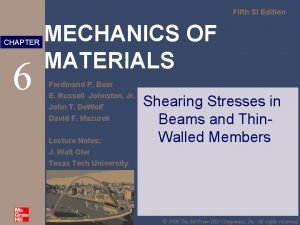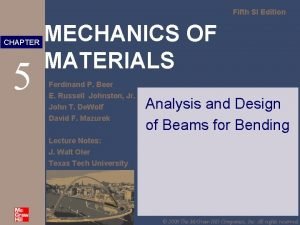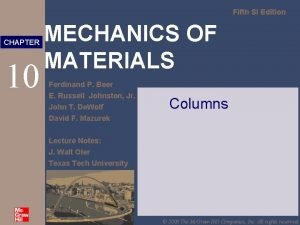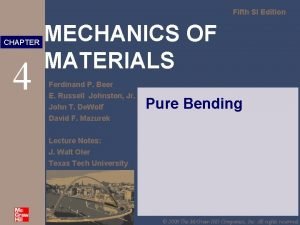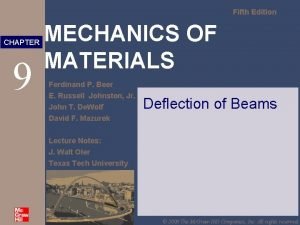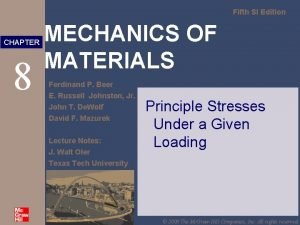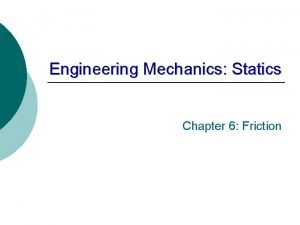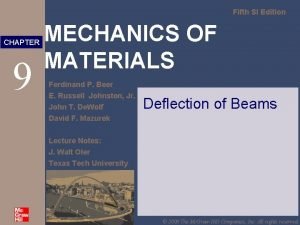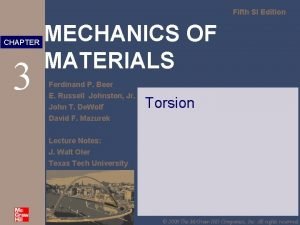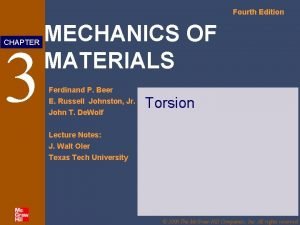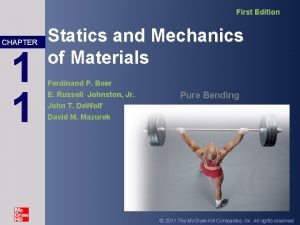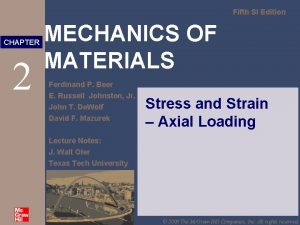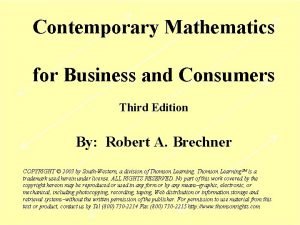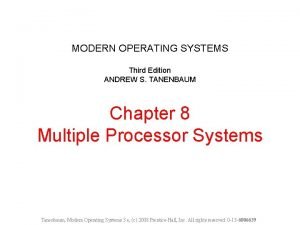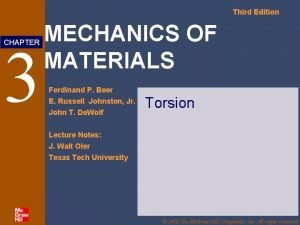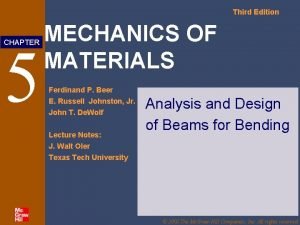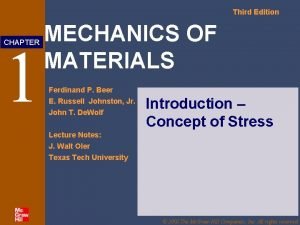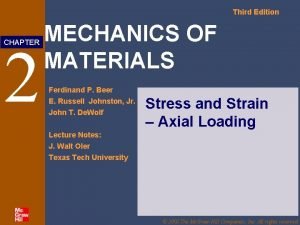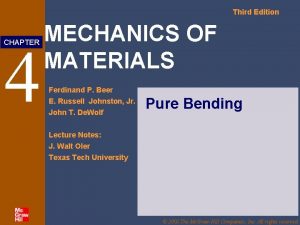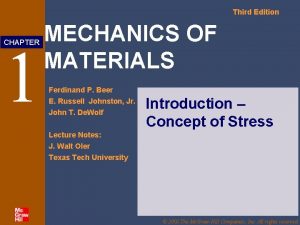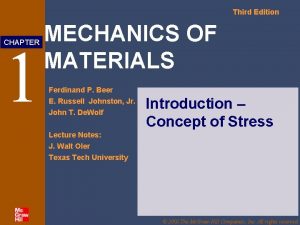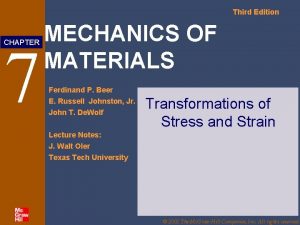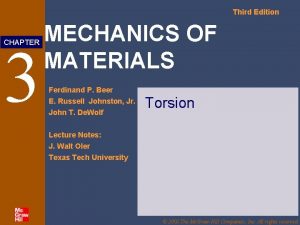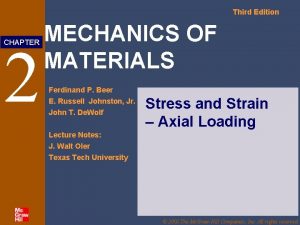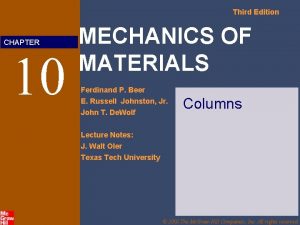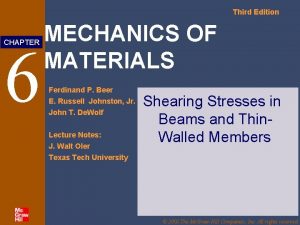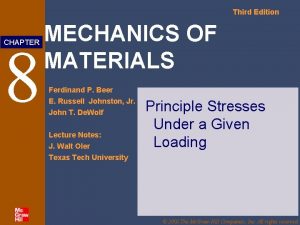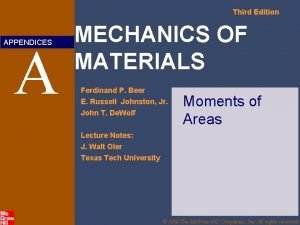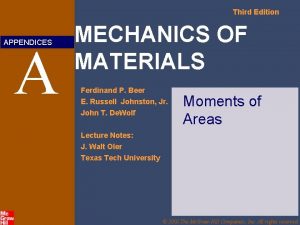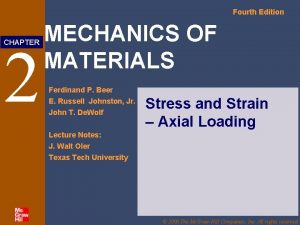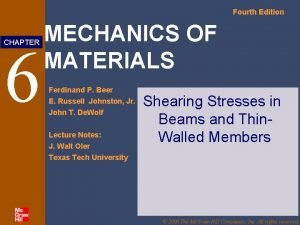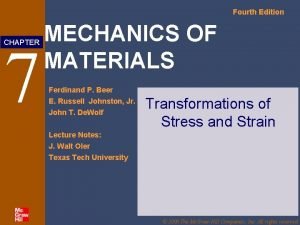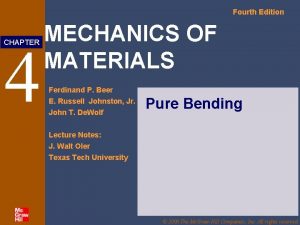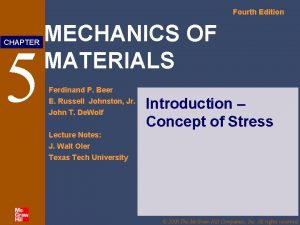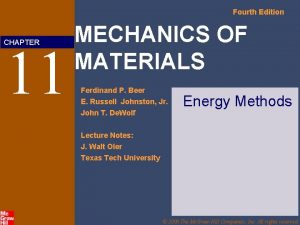Third Edition 1 CHAPTER MECHANICS OF MATERIALS Ferdinand

























- Slides: 25

Third Edition 1 CHAPTER MECHANICS OF MATERIALS Ferdinand P. Beer E. Russell Johnston, Jr. John T. De. Wolf Introduction – Concept of Stress Lecture Notes: J. Walt Oler Texas Tech University © 2002 The Mc. Graw-Hill Companies, Inc. All rights reserved.

Third Edition MECHANICS OF MATERIALS Beer • Johnston • De. Wolf Contents Concept of Stress Bearing Stress in Connections Review of Statics Stress Analysis & Design Example Structure Free-Body Diagram Rod & Boom Normal Stresses Component Free-Body Diagram Pin Shearing Stresses Method of Joints Pin Bearing Stresses Stress Analysis Stress in Two Force Members Design Stress on an Oblique Plane Axial Loading: Normal Stress Maximum Stresses Centric & Eccentric Loading Stress Under General Loadings Shearing Stress State of Stress Shearing Stress Examples Factor of Safety © 2002 The Mc. Graw-Hill Companies, Inc. All rights reserved. 2

Third Edition MECHANICS OF MATERIALS Beer • Johnston • De. Wolf Concept of Stress • The main objective of the study of mechanics of materials is to provide the future engineer with the means of analyzing and designing various machines and load bearing structures. • Both the analysis and design of a given structure involve the determination of stresses and deformations. This chapter is devoted to the concept of stress. © 2002 The Mc. Graw-Hill Companies, Inc. All rights reserved. 3

Third Edition MECHANICS OF MATERIALS Beer • Johnston • De. Wolf Review of Statics • The structure is designed to support a 30 k. N load • The structure consists of a boom and rod joined by pins (zero moment connections) at the junctions and supports • Perform a static analysis to determine the internal force in each structural member and the reaction forces at the supports © 2002 The Mc. Graw-Hill Companies, Inc. All rights reserved. 4

Third Edition MECHANICS OF MATERIALS Beer • Johnston • De. Wolf Structure Free-Body Diagram • Structure is detached from supports and the loads and reaction forces are indicated • Conditions for static equilibrium: • Ay and Cy can not be determined from these equations © 2002 The Mc. Graw-Hill Companies, Inc. All rights reserved. 5

Third Edition MECHANICS OF MATERIALS Beer • Johnston • De. Wolf Component Free-Body Diagram • In addition to the complete structure, each component must satisfy the conditions for static equilibrium • Consider a free-body diagram for the boom: substitute into the structure equilibrium equation • Results: Reaction forces are directed along boom and rod © 2002 The Mc. Graw-Hill Companies, Inc. All rights reserved. 6

Third Edition MECHANICS OF MATERIALS Beer • Johnston • De. Wolf Method of Joints • The boom and rod are 2 -force members, i. e. , the members are subjected to only two forces which are applied at member ends • For equilibrium, the forces must be parallel to to an axis between the force application points, equal in magnitude, and in opposite directions • Joints must satisfy the conditions for static equilibrium which may be expressed in the form of a force triangle: © 2002 The Mc. Graw-Hill Companies, Inc. All rights reserved. 7

Third Edition MECHANICS OF MATERIALS Beer • Johnston • De. Wolf Stress Analysis Can the structure safely support the 30 k. N load? • From a statics analysis FAB = 40 k. N (compression) FBC = 50 k. N (tension) • At any section through member BC, the internal force is 50 k. N with a force intensity or stress of d. BC = 20 mm • From the material properties for steel, the allowable stress is • Conclusion: the strength of member BC is adequate © 2002 The Mc. Graw-Hill Companies, Inc. All rights reserved. 8

Third Edition MECHANICS OF MATERIALS Beer • Johnston • De. Wolf Design • Design of new structures requires selection of appropriate materials and component dimensions to meet performance requirements • For reasons based on cost, weight, availability, etc. , the choice is made to construct the rod from aluminum (sall= 100 MPa). What is an appropriate choice for the rod diameter? • An aluminum rod 26 mm or more in diameter is adequate © 2002 The Mc. Graw-Hill Companies, Inc. All rights reserved. 9

Third Edition MECHANICS OF MATERIALS Beer • Johnston • De. Wolf Axial Loading: Normal Stress • The resultant of the internal forces for an axially loaded member is normal to a section cut perpendicular to the member axis. • The force intensity on that section is defined as the normal stress. • The normal stress at a particular point may not be equal to the average stress but the resultant of the stress distribution must satisfy • The detailed distribution of stress is statically indeterminate, i. e. , can not be found from statics alone. © 2002 The Mc. Graw-Hill Companies, Inc. All rights reserved. 10

Third Edition MECHANICS OF MATERIALS Beer • Johnston • De. Wolf Centric & Eccentric Loading • A uniform distribution of stress in a section infers that the line of action for the resultant of the internal forces passes through the centroid of the section. • A uniform distribution of stress is only possible if the concentrated loads on the end sections of two-force members are applied at the section centroids. This is referred to as centric loading. • If a two-force member is eccentrically loaded, then the resultant of the stress distribution in a section must yield an axial force and a moment. • The stress distributions in eccentrically loaded members cannot be uniform or symmetric. © 2002 The Mc. Graw-Hill Companies, Inc. All rights reserved. 11

Third Edition MECHANICS OF MATERIALS Beer • Johnston • De. Wolf Shearing Stress • Forces P and P’ are applied transversely to the member AB. • Corresponding internal forces act in the plane of section C and are called shearing forces. • The resultant of the internal shear force distribution is defined as the shear of the section and is equal to the load P. • The corresponding average shear stress is, • Shear stress distribution varies from zero at the member surfaces to maximum values that may be much larger than the average value. • The shear stress distribution cannot be assumed to be uniform. © 2002 The Mc. Graw-Hill Companies, Inc. All rights reserved. 12

Third Edition MECHANICS OF MATERIALS Beer • Johnston • De. Wolf Shearing Stress Examples Single Shear © 2002 The Mc. Graw-Hill Companies, Inc. All rights reserved. Double Shear 13

Third Edition MECHANICS OF MATERIALS Beer • Johnston • De. Wolf Bearing Stress in Connections • Bolts, rivets, and pins create stresses on the points of contact or bearing surfaces of the members they connect. • The resultant of the force distribution on the surface is equal and opposite to the force exerted on the pin. • Corresponding average force intensity is called the bearing stress, © 2002 The Mc. Graw-Hill Companies, Inc. All rights reserved. 14

Third Edition MECHANICS OF MATERIALS Beer • Johnston • De. Wolf Stress Analysis & Design Example • Would like to determine the stresses in the members and connections of the structure shown. • From a statics analysis: FAB = 40 k. N (compression) FBC = 50 k. N (tension) • Must consider maximum normal stresses in AB and BC, and the shearing stress and bearing stress at each pinned connection © 2002 The Mc. Graw-Hill Companies, Inc. All rights reserved. 15

Third Edition MECHANICS OF MATERIALS Beer • Johnston • De. Wolf Rod & Boom Normal Stresses • The rod is in tension with an axial force of 50 k. N. • At the rod center, the average normal stress in the circular cross-section (A = 314 x 10 -6 m 2) is s. BC = +159 MPa. • At the flattened rod ends, the smallest cross-sectional area occurs at the pin centerline, • The boom is in compression with an axial force of 40 k. N and average normal stress of – 26. 7 MPa. • The minimum area sections at the boom ends are unstressed since the boom is in compression. © 2002 The Mc. Graw-Hill Companies, Inc. All rights reserved. 16

Third Edition MECHANICS OF MATERIALS Beer • Johnston • De. Wolf Pin Shearing Stresses • The cross-sectional area for pins at A, B, and C, • The force on the pin at C is equal to the force exerted by the rod BC, • The pin at A is in double shear with a total force equal to the force exerted by the boom AB, © 2002 The Mc. Graw-Hill Companies, Inc. All rights reserved. 17

Third Edition MECHANICS OF MATERIALS Beer • Johnston • De. Wolf Pin Shearing Stresses • Divide the pin at B into sections to determine the section with the largest shear force, • Evaluate the corresponding average shearing stress, © 2002 The Mc. Graw-Hill Companies, Inc. All rights reserved. 18

Third Edition MECHANICS OF MATERIALS Beer • Johnston • De. Wolf Pin Bearing Stresses • To determine the bearing stress at A in the boom AB, we have t = 30 mm and d = 25 mm, • To determine the bearing stress at A in the bracket, we have t = 2(25 mm) = 50 mm and d = 25 mm, © 2002 The Mc. Graw-Hill Companies, Inc. All rights reserved. 19

Third Edition MECHANICS OF MATERIALS Beer • Johnston • De. Wolf Stress in Two Force Members • Axial forces on a two force member result in only normal stresses on a plane cut perpendicular to the member axis. • Transverse forces on bolts and pins result in only shear stresses on the plane perpendicular to bolt or pin axis. • Will show that either axial or transverse forces may produce both normal and shear stresses with respect to a plane other than one cut perpendicular to the member axis. © 2002 The Mc. Graw-Hill Companies, Inc. All rights reserved. 20

Third Edition MECHANICS OF MATERIALS Beer • Johnston • De. Wolf Stress on an Oblique Plane • Pass a section through the member forming an angle q with the normal plane. • From equilibrium conditions, the distributed forces (stresses) on the plane must be equivalent to the force P. • Resolve P into components normal and tangential to the oblique section, • The average normal and shear stresses on the oblique plane are © 2002 The Mc. Graw-Hill Companies, Inc. All rights reserved. 21

Third Edition MECHANICS OF MATERIALS Beer • Johnston • De. Wolf Maximum Stresses • Normal and shearing stresses on an oblique plane • The maximum normal stress occurs when the reference plane is perpendicular to the member axis, • The maximum shear stress occurs for a plane at + 45 o with respect to the axis, © 2002 The Mc. Graw-Hill Companies, Inc. All rights reserved. 22

Third Edition MECHANICS OF MATERIALS Beer • Johnston • De. Wolf Stress Under General Loadings • A member subjected to a general combination of loads is cut into two segments by a plane passing through Q • The distribution of internal stress components may be defined as, • For equilibrium, an equal and opposite internal force and stress distribution must be exerted on the other segment of the member. © 2002 The Mc. Graw-Hill Companies, Inc. All rights reserved. 23

Third Edition MECHANICS OF MATERIALS Beer • Johnston • De. Wolf State of Stress • Stress components are defined for the planes cut parallel to the x, y and z axes. For equilibrium, equal and opposite stresses are exerted on the hidden planes. • The combination of forces generated by the stresses must satisfy the conditions for equilibrium: • Consider the moments about the z axis: • It follows that only 6 components of stress are required to define the complete state of stress © 2002 The Mc. Graw-Hill Companies, Inc. All rights reserved. 24

Third Edition MECHANICS OF MATERIALS Beer • Johnston • De. Wolf Factor of Safety Structural members or machines must be designed such that the working stresses are less than the ultimate strength of the material. Factor of safety considerations: • uncertainty in material properties • uncertainty of loadings • uncertainty of analyses • number of loading cycles • types of failure • maintenance requirements and deterioration effects • importance of member to structures integrity • risk to life and property • influence on machine function © 2002 The Mc. Graw-Hill Companies, Inc. All rights reserved. 25
 Mechanics of materials 6th edition solutions chapter 10
Mechanics of materials 6th edition solutions chapter 10 Chapter 7 beer
Chapter 7 beer Mechanics
Mechanics Mechanics
Mechanics Mechanics of materials 7th edition solutions chapter 10
Mechanics of materials 7th edition solutions chapter 10 Mechanic of materials
Mechanic of materials Mechanics of materials 6th edition solutions chapter 9
Mechanics of materials 6th edition solutions chapter 9 Mechanics of materials
Mechanics of materials Engineering mechanics (9th) edition chapter 12 problem 30p
Engineering mechanics (9th) edition chapter 12 problem 30p Engineering mechanics force system
Engineering mechanics force system Mechanics of materials chapter 9
Mechanics of materials chapter 9 Mechanics of materials chapter 3
Mechanics of materials chapter 3 Mechanics of materials chapter 3 solutions
Mechanics of materials chapter 3 solutions Mechanics of materials chapter 3 solutions
Mechanics of materials chapter 3 solutions Mechanics
Mechanics Gj mount classification of dental caries
Gj mount classification of dental caries Senile carious lesions
Senile carious lesions Principles of economics third edition
Principles of economics third edition Reaction of grignard reagent with acid chloride
Reaction of grignard reagent with acid chloride Organic chemistry third edition david klein
Organic chemistry third edition david klein Business mathematics third edition
Business mathematics third edition Distributed systems third edition
Distributed systems third edition Fundamentals of corporate finance canadian edition
Fundamentals of corporate finance canadian edition Fundamentals of corporate finance, third canadian edition
Fundamentals of corporate finance, third canadian edition Lifespan development third edition
Lifespan development third edition Lifespan development third edition
Lifespan development third edition


